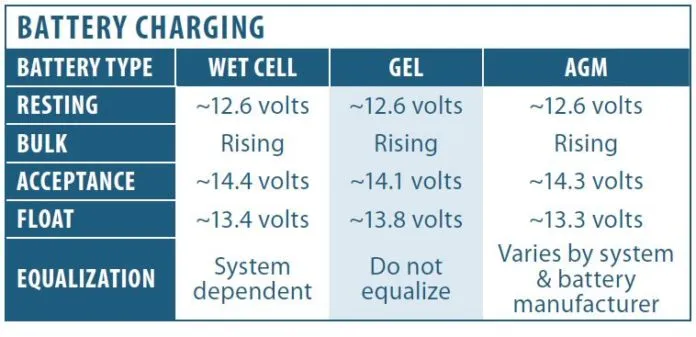Gel-cell technology has been around for a number of years now. But the batteries got off to a bad start, largely due to promises of life cycling that were too optimistic. Even worse, there was little or no warning of the voltage limits of the battery (they must be charged at no more than about 14.1 volts). We know many sailors who bought gel cells expecting great performance, installed them in a boat with the standard battery charger (that charges at more than 14.1 volts), then wondered why the batteries failed after just a few weeks.
All gel batteries are not created equal. The big three gel manufacturers: EastPenn, Johnson Controls and Exide differ remarkably in how they make their products and what they put into them. Gel cells differ considerably from their wet-cell counterparts in that the grid inside is made of calcium/copper alloy. Calcium may be used in starting batteries to enable the battery to give up large amounts of energy for short periods of time, but is less desirable for deep cycling.
How do the gel cells get away with it and why do they use calcium? The first reason is the ability of the battery to use the power from the gelled electrolyte, which has the consistency of wax, instead of taking it from the plates. The plates are not stressed as much in this manner. Secondly, calcium is a very low-resistance material and allows the gel cell to accept a higher rate of charge in the beginning of the charge cycle. Thirdly, gel batteries have the ability to sit for very long periods of time with very little self discharge, even in warm temperatures. In taking the cells apart, it was interesting to note that these batteries continued to show voltage on our meter, owing to the power being stored in the gel mixture, even with most of the internal cells severely cut away.
Another asset of the gel battery is its ability to be sit on its side or end, solving battery space problems, but expect up to a 10% loss of performance. In a pinch, a gel cell could even be built into a semi-dry bilge as it is totally sealed via its special cell caps and operates at a positive internal pressure of up to l-l/2 psi, thus the puckered look of the case assembly at times.
Gel batteries never need maintenance. Their recombination technique replaces the lost moisture in the battery as long as the integrity of the closed cell is intact. A sure way to destroy the battery is to overcharge it, which drives out the oxygen and hydrogen via the cap; the result will be a dried out cell. All gel cell battery manufactures recommend special charging procedures with particular attention to the final charging voltages. And yes, gel batteries do make good starting batteries.
For more information on marine batteries and other electrical systems, check out Marine Electrical Systems, Vol. 1: Batteries from Practical Sailor.









































